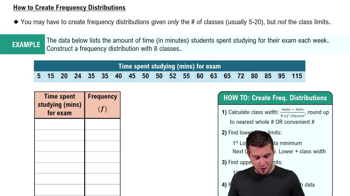Here are the essential concepts you must grasp in order to answer the question correctly.
Control Limits
Control limits are statistical boundaries set on a control chart that define the expected range of variation in a process. They are typically calculated using the mean and standard deviation of the process data, establishing an upper control limit (UCL) and a lower control limit (LCL). These limits help identify whether a process is in control or if there are variations that may indicate a problem.
Recommended video:
How to Create Frequency Distributions
Upper and Lower Control Limits
The upper control limit (UCL) is the maximum threshold that a process should not exceed, while the lower control limit (LCL) is the minimum threshold that should not be breached. These limits are crucial for monitoring process stability and performance, as points outside these limits signal potential issues that require investigation and corrective action.
Recommended video:
How to Create Frequency Distributions
Purpose of Control Limits
The primary purpose of control limits is to provide a visual representation of process variability and to help detect trends or shifts in the process. By analyzing data points in relation to these limits, organizations can maintain quality control, identify areas for improvement, and ensure that processes remain consistent and predictable over time.
Recommended video:
How to Create Frequency Distributions




